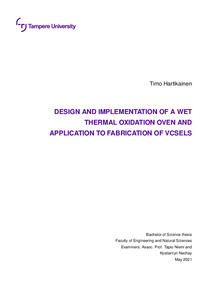Design and Implementation of a Wet Thermal Oxidation Oven and Application to Fabrication of VCSELs
Hartikainen, Timo (2021)
Hartikainen, Timo
2021
Tekniikan ja luonnontieteiden kandidaattiohjelma - Bachelor's Programme in Engineering and Natural Sciences
Tekniikan ja luonnontieteiden tiedekunta - Faculty of Engineering and Natural Sciences
This publication is copyrighted. You may download, display and print it for Your own personal use. Commercial use is prohibited.
Hyväksymispäivämäärä
2021-05-24
Julkaisun pysyvä osoite on
https://urn.fi/URN:NBN:fi:tuni-202105155023
https://urn.fi/URN:NBN:fi:tuni-202105155023
Tiivistelmä
The purpose of this thesis was to design and implement a wet thermal oxidation oven optimized for the fabrication of vertical-cavity surface-emitting lasers (VCSEL). An oxide aperture created by the lateral oxidation of a VCSEL structure plays an important role in the operation of the device. It creates a current aperture that enables the confinement of carriers and photons within a small active region to emit light. The diameter and symmetry of the oxide aperture must be adjusted precisely in order to meet the requirements defined by the electro-optical characteristics of the device.
This work investigated the oxidation processes of semiconductor materials and the working principle of a wet thermal oxidation oven. Based on the research, the wet thermal oxidation oven built in this work included a quartz process chamber, an IR heating element and a dedicated water vapor production system. Samples were placed on a graphite carrier which absorbed and distributed the radiation of the heating element. The temperature of the carrier was measured with a Pt100 resistance thermometer, and the temperature of the sample was measured directly with an IR pyrometer. The power of the heating element was regulated by a PID temperature controller. All process parameters were controlled by automated computer software in order to increase run-to-run reproducibility.
The most important control parameters of an oxidation oven were found to be sample temperature, carrier gas flow rate, water vapor concentration and oxidation time. Also, the position and orientation of the sample in a process chamber may have a great effect on the oxidation result. The accuracy of the process can be improved significantly with an integrated in-situ monitoring system.
As a result of the work, the uniformity of the lateral oxidation depth across macro samples (with a typical size of several centimeters) has reached values lower than ±0.5 μm. Also, an excellent symmetry of the oxide apertures has been achieved. Oxidized VCSEL structures were successfully processed into well-functioning single-emitters operating in single mode, which is considered to be an untrivial task, especially without integrating expensive in-situ monitoring into the system.
The future development of the oxidation oven will focus on adding an in-situ monitoring capability to the system, which will increase the reliability and output quality of the process. Another improvement will be increasing the size of the sample in order to use the system in a commercial manufacturing process.
This work investigated the oxidation processes of semiconductor materials and the working principle of a wet thermal oxidation oven. Based on the research, the wet thermal oxidation oven built in this work included a quartz process chamber, an IR heating element and a dedicated water vapor production system. Samples were placed on a graphite carrier which absorbed and distributed the radiation of the heating element. The temperature of the carrier was measured with a Pt100 resistance thermometer, and the temperature of the sample was measured directly with an IR pyrometer. The power of the heating element was regulated by a PID temperature controller. All process parameters were controlled by automated computer software in order to increase run-to-run reproducibility.
The most important control parameters of an oxidation oven were found to be sample temperature, carrier gas flow rate, water vapor concentration and oxidation time. Also, the position and orientation of the sample in a process chamber may have a great effect on the oxidation result. The accuracy of the process can be improved significantly with an integrated in-situ monitoring system.
As a result of the work, the uniformity of the lateral oxidation depth across macro samples (with a typical size of several centimeters) has reached values lower than ±0.5 μm. Also, an excellent symmetry of the oxide apertures has been achieved. Oxidized VCSEL structures were successfully processed into well-functioning single-emitters operating in single mode, which is considered to be an untrivial task, especially without integrating expensive in-situ monitoring into the system.
The future development of the oxidation oven will focus on adding an in-situ monitoring capability to the system, which will increase the reliability and output quality of the process. Another improvement will be increasing the size of the sample in order to use the system in a commercial manufacturing process.
Kokoelmat
- Kandidaatintutkielmat [7041]
